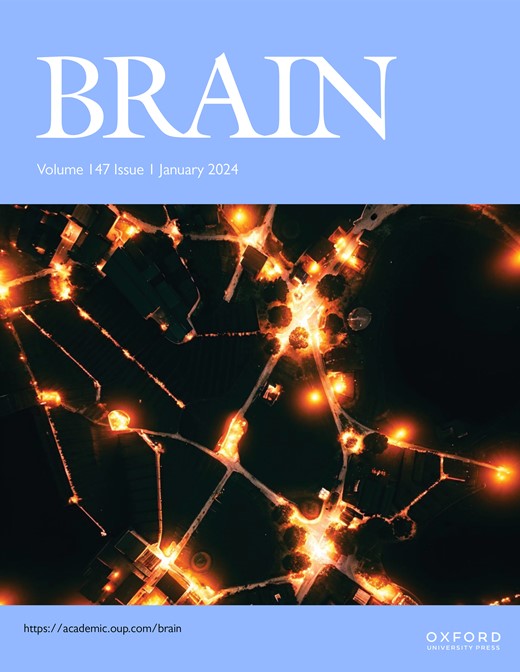Plasma periaxin is a biomarker of peripheral nerve demyelination
IF 11.7
1区 医学
Q1 CLINICAL NEUROLOGY
引用次数: 0
Abstract
Assessing disease progression and informing clinical trials in peripheral neuropathy would benefit from objective and responsive fluid biomarkers closely linked to disease biology. This is particularly important in chronic inflammatory demyelinating polyradiculoneuropathy (CIDP) and Guillain-Barré syndrome (GBS), the most common inflammatory neuropathies, where reliable biomarkers of peripheral demyelination would help identify, and potentially measure, active disease and responses to treatment. We postulated that periaxin, a protein exclusively expressed by myelinating Schwann cells, could serve as a fluid biomarker of demyelinating peripheral neuropathy. We developed a Simoa-based immunoassay to measure plasma periaxin in patients with CIDP (n = 45, including longitudinal samples across a discovery cohort and a validation cohort, for a total of 77 time points), GBS (n = 30, 66 time points), Charcot-Marie-Tooth disease (CMT, n = 20), central nervous system (CNS) disease controls with multiple sclerosis (MS, n = 30), and healthy controls (HC, n = 30). We also evaluated whether periaxin is released in myelinating cocultures following immune-mediated demyelination and axonal damage, comparing results with uninjured cultures. Plasma periaxin effectively distinguishes peripheral from central nervous system diseases, with significantly elevated levels in CIDP, GBS, and CMT, but not in CNS disease or healthy controls (all P < 0.01). In CIDP, periaxin discriminates patients with active disease from those with inactive disease (P < 0.0001), and plasma levels decrease following treatment with intravenous immunoglobulin (IVIg). Elevated periaxin strongly predicts clinical worsening at 1 year [sensitivity 99%, specificity 72%, area under the curve (AUC) 0.86 (95% C.I. 0.67–1)]. In GBS, peak levels of plasma periaxin and the ratio of periaxin to axonal biomarkers [neurofilament light chain (NfL) and peripherin] discriminate most cases of acute inflammatory demyelinating polyradiculoneuropathy (AIDP) from acute motor axonal neuropathy (AMAN), as classified by electrophysiology (sensitivity 100%, specificity 86%, AUC = 0.94, 95% CI 0.81-1). Serial measurements showed that plasma periaxin levels peak 2 to 3 weeks after GBS symptom onset, followed by a gradual decline in the weeks thereafter. In vitro, periaxin is higher following immune-mediated demyelination compared to axonal damage and control conditions. Plasma periaxin is a biomarker of peripheral nerve demyelination. Combined with axonal fluid biomarkers and existing clinical scales, periaxin has the potential to improve the clinical management of peripheral neuropathies, accelerating advances in care and experimental research.血浆周轴素是周围神经脱髓鞘的生物标志物
评估周围神经病变的疾病进展和为临床试验提供信息,将受益于与疾病生物学密切相关的客观和反应性液体生物标志物。这在慢性炎症性脱髓鞘性多根神经病变(CIDP)和格林-巴勒综合征(GBS)中尤其重要,这是最常见的炎症性神经病变,其中可靠的外周脱髓鞘生物标志物将有助于识别并潜在地测量活动性疾病和对治疗的反应。我们假设periaxin,一种由髓鞘形成的雪旺细胞专门表达的蛋白,可以作为脱髓鞘周围神经病变的液体生物标志物。我们开发了一种基于simoa的免疫分析法,用于测量CIDP (n = 45,包括发现队列和验证队列的纵向样本,共77个时间点)、GBS (n = 30, 66个时间点)、沙克-玛丽-图斯病(CMT, n = 20)、多发性硬化症中枢神经系统(CNS)疾病对照(MS, n = 30)和健康对照(HC, n = 30)患者的血浆周轴素。我们还评估了在免疫介导的脱髓鞘和轴突损伤后髓鞘共培养物中是否释放周轴素,并将结果与未损伤的培养物进行比较。血浆环周蛋白可有效区分外周神经系统疾病和中枢神经系统疾病,在CIDP、GBS和CMT中,血浆环周蛋白水平显著升高,但在中枢神经系统疾病或健康对照中则无显著升高(P <;0.01)。在CIDP中,periaxin可以区分活动性疾病患者和非活动性疾病患者(P <;0.0001),静脉注射免疫球蛋白(IVIg)治疗后血浆水平降低。环氨嘧啶升高强烈预测1年后临床恶化[敏感性99%,特异性72%,曲线下面积(AUC) 0.86 (95% ci 0.67-1)]。在GBS中,血浆周轴素的峰值水平和周轴素与轴突生物标志物[神经丝轻链(NfL)和周轴素]的比值将大多数急性炎症性脱髓鞘性多根神经病变(AIDP)与急性运动轴突神经病变(AMAN)区分开来,通过电生理学进行分类(敏感性100%,特异性86%,AUC = 0.94, 95% CI 0.81-1)。连续测量显示,血浆环氨嘧啶水平在GBS症状出现后2至3周达到峰值,随后在几周内逐渐下降。体外,与轴突损伤和对照条件相比,免疫介导脱髓鞘后的周轴素更高。血浆周轴素是周围神经脱髓鞘的生物标志物。结合轴突液体生物标志物和现有的临床量表,periaxin有可能改善周围神经病变的临床管理,加速护理和实验研究的进展。
本文章由计算机程序翻译,如有差异,请以英文原文为准。
求助全文
约1分钟内获得全文
求助全文
来源期刊

Brain
医学-临床神经学
CiteScore
20.30
自引率
4.10%
发文量
458
审稿时长
3-6 weeks
期刊介绍:
Brain, a journal focused on clinical neurology and translational neuroscience, has been publishing landmark papers since 1878. The journal aims to expand its scope by including studies that shed light on disease mechanisms and conducting innovative clinical trials for brain disorders. With a wide range of topics covered, the Editorial Board represents the international readership and diverse coverage of the journal. Accepted articles are promptly posted online, typically within a few weeks of acceptance. As of 2022, Brain holds an impressive impact factor of 14.5, according to the Journal Citation Reports.
 求助内容:
求助内容: 应助结果提醒方式:
应助结果提醒方式:


